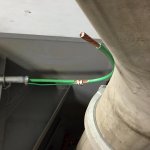see attached picture.
I have a 2/0 ground conductor grounding an electro deposition tank in six locations. We have a # 6 tapping off the 2/0 going back to the RGC bond bushing (choke). The Safety department is saying the application is not right. They are saying the 2/0 should go thru the bond bushing.
I am thinking since the 2/0 cable is insulated the # 6 is not even required.
Please advise, thank you...
I have a 2/0 ground conductor grounding an electro deposition tank in six locations. We have a # 6 tapping off the 2/0 going back to the RGC bond bushing (choke). The Safety department is saying the application is not right. They are saying the 2/0 should go thru the bond bushing.
I am thinking since the 2/0 cable is insulated the # 6 is not even required.
Please advise, thank you...




